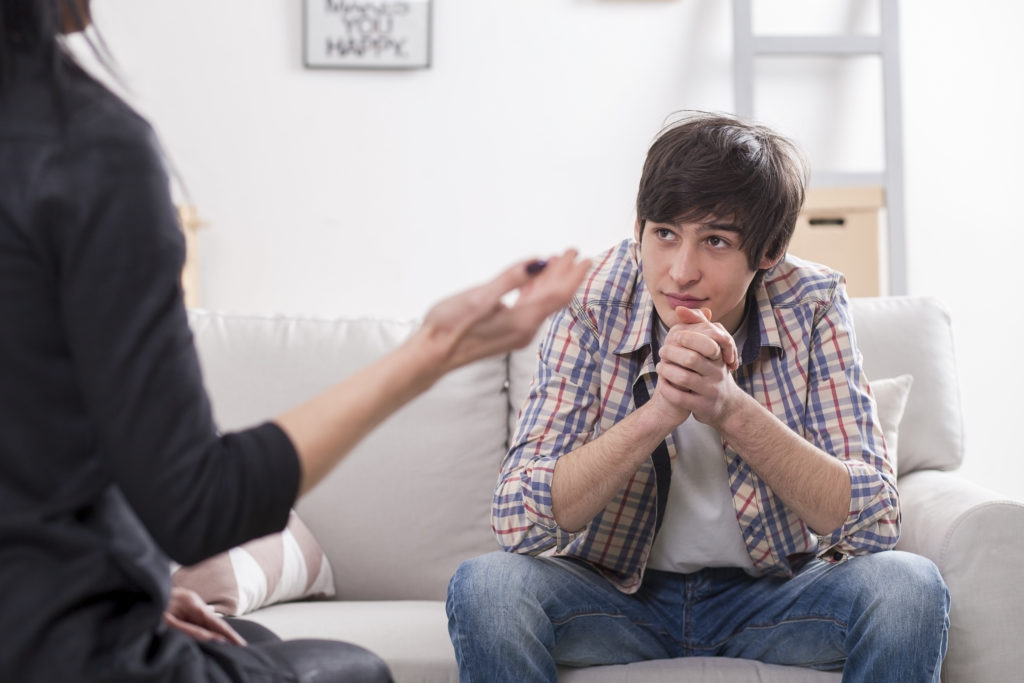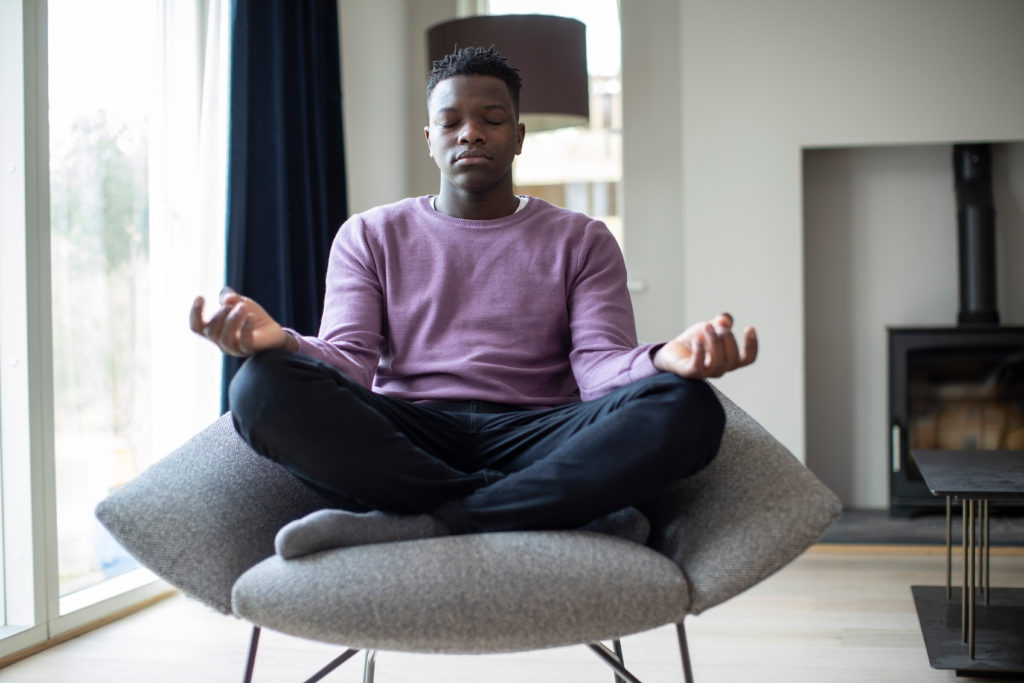Mindfulness: Helping Anxious Teens in an Anxious World
By Janet DiGiorgio-Miller, PhD
I am a psychologist who works with at-risk children and adolescents, as well as their families. Many of the teens with whom I work experience anxiety, and are unable to effectively manage their experiences of stress. This has only increased under current social circumstances, in which, during these “extraordinary and uncertain times,” it is “normal” for teens to be worried.1

Child and adolescent anxiety has increased during this time of increased stress, as it has for all people. It’s important to put that anxiety into context, though, and recognize that anxiety in children and adolescents is not the result of Covid-19 alone. That is, the resolution of our current health crisis will not necessarily alleviate underlying circumstances that contribute to pediatric anxiety, and neither are we, as individual practitioners, able to significantly alleviate many of those circumstances. Instead, our role, recognizing the prevalence of anxiety among young people, is in part to help our clients effectively manage their anxiety.

As one part of my treatment “toolkit,” I use meditation and mindfulness to help clients who experience stress and anxiety in their general lives, and even more so at this time of increased stress to themselves, their families and friends, and to their communities. I’ll describe two mindfulness-based techniques that you may find helpful in your work with anxious, or any, teens. First, however, let’s put child and adolescent anxiety during this time itself into context.’
Child and Adolescent Anxiety: It’s An Anxious Time
Anxiety has been the most prevalent mental health disorder experienced by children and adolescents in the United States for decades. In 1999, the U.S. Surgeon General described the prevalence of pediatric anxiety disorders in the U.S. as higher than that of all other mental disorders of childhood and adolescence, experienced by 13 percent of children and teenagers.2 In addition, as described by the Surgeon General, the relationship between childhood mental disorders and stressful life events is well-established, in which adverse developmental and environmental factors are part of the context within which mental or behavioral health difficulties occur. “Even more than for adults … children must be seen in the context of their social environments.”3 It’s no surprise, then, that anxiety in children and teens has increased during the pandemic.
I find that some anxious children and teens actually feel more comfortable during the isolation, and especially so if they experience social anxiety (social interactions which are themselves anxiety-provoking). Recognizing context helps explain why. Required restrictions partly eliminate the stress that social interactions and expectations may otherwise bring. At the same time, these young people also have more time to imagine the worst for themselves, their families, and the world around them. On top of that, being in limbo itself may increase anxiety. Even social media, to which many young people naturally gravitate, has become a stressful environment due to racial and political tensions.
Let’s get back to what helps. We need to address the source of anxiety for young people, but we also need to address and treat the anxiety itself, helping remediate anxiety for adolescents and help them discover ways to better manage for themselves their experiences of stress.
Helping Tools: Meditative Techniques
I use mindfulness and meditative techniques in my work, and find it both helpful and important to add these additional tools to traditional therapy when working with anxious teens. Indeed, meditation is supported by research as helpful in managing anxiety.4, 5 Nevertheless, it’s difficult for many clients to embrace these techniques or ideas because they may have difficulty sustaining focus or finding time, or remembering to meditate, or perhaps even believing that mediation is effective or has a place in their life. These are obstacles to overcome in helping young people learn that they have the capacity to manage their anxiety, in part by breathing, attending to the moment, and grounding themselves. Attention to the present moment disrupts the anxious “thought train,” allowing children and teens to focus on managing their anxiety, instead of feeling helpless. Clients who learn and actively use this coping technique are more apt to try more formal mediation, furthering their ability to manage anxiety.
Breathing and Mindfulness

When we take a pause, breathing in a meditative fashion (for instance, counting to 4 with each breath in and out, several times), a more mindful state of mind develops in which we are able to consider and adopt a more balanced perspective. Mindfulness can create a comfort zone in which our clients can use their own breath or surroundings to feel grounded in an unpredictable world. Mindfulness is empowering when teens learn that if they can manage their breath, they can slow the beat of their heart, emotionally relax, better handle stress, and make better decisions.

Mindfulness and Compassion
Compassion for self and others enhances the body’s preparedness for stress.6, 7 Mindfulness allows young people to become more aware of their judgments and adopt a kinder view of themselves and others. This takes practice, of course, as the self-perceptions of many at-risk adolescents often lead to harsh self-evaluation and evaluation of others. One simple technique teaches young people how to take a mindful pause in order to notice critical self-talk—but just notice, not judge. They are thus able to become more aware of these automatic negative thoughts and can use a mindful space to challenge them. Similarly, the “lovingkindness” meditation—which has young people wishing well to themselves, someone they love, someone they find difficult, and the world around them—usually involves four simple phrases related to being safe, being healthy, being calm, and living life with ease.
As with other mindfulness techniques, these methods take practice and regular use. And there are easily accessible resources. Dr. Kristen Neff’s website, for instance, describes and teaches self-compassion and other techniques (https://self-compassion.org), which may be further acceptable to teens already comfortable with online technology.

Changing Focus: Practice, Practice, Practice
Anxiety often leads to a problematic form of self-focus, in which anxious young people focus on holding their anxieties at bay, rather than on managing it and being present and part of the world around them. It is important to help them learn how to better respond to others, but it is also important to help them become more mindful in their interactions with others. Mindfully listening to and interacting with others, helps others become more attuned to the young person. This in turn creates a safer emotional and social environment for the teen. For many at-risk teens, this process is not natural; it takes a while, and practice, for them to develop the skills to take pause and be present. It is the practitioners’ job to be mindfully patient, and support the teen through this process of learning and practice. In order to do so, as the pandemic affects us as well as our clients, it is important that we take care of ourselves mentally, emotionally, and physically. Self-care can include the very techniques listed above.
Namaste.
1. Parsons, J. (2020). COVID-19, children and anxiety in 2020. Australian Journal of General Practice, 49 Suppl 27. https://www1.racgp.org.au/ajgp/coronavirus/covid-19-children-and-anxiety-in-2020
Janet DiGiorgio-Miller is a licensed psychologist in private practice in New Jersey. She has over 30 years of clinical experience in working with adolescents and families. Dr. DiGiorgio-Miller specializes in mindfulness, and treatment of relationships and anxiety. She is also a forensic psychologist specializing in parenting time and divorce. She has been a frequent presenter both locally and nationally on various topics, including reunification, relationship issues, and mindfulness. Dr. DiGiorgio-Miller has several publications in the field and published a self-help book for young adults titled, A Great Relationship & Then Some.
2. U. S. Department of Health and Human Services. (1999). Mental health: A report of the Surgeon-General. https://www.hsdl.org/?abstract&did=730796 \
3. Satcher, D. S. (2000, Jan-Feb). Executive summary: A report of the Surgeon General on mental health. Public Health Report, 115(1), 89–101. https://www.ncbi.nlm.nih.gov/pmc/articles/PMC1308561/pdf/pubhealthrep00023-0091.pdf
4. Jennings, S. J., & Jennings, J. L. (2013). Peer-directed, brief mindfulness training with adolescents: A pilot study. International Journal of Behavioral Consultation and Therapy, 8(2), 23.
5. Mostafazadeh, P., Ebadi, Z., Mousavi, S., & Nouroozi, N. (2019). Effectiveness of School-Based Mindfulness Training as a Program to Prevent Stress, Anxiety, and Depression in High School Students. Health Education and Health Promotion, 7(3), 1-6.
6. Bluth, K., & Eisenlohr-Moul, T. A. (2017). Response to a mindful self-compassion intervention in teens: A within-person association of mindfulness, self-compassion, and emotional well-being outcomes. Journal of adolescence, 57, 108–118. https://doi.org/10.1016/j.adolescence.2017.04.001
7. Lathren, C., Bluth, K., & Park, J. (2019). Adolescent Self-Compassion Moderates the Relationship Between Perceived Stress and Internalizing Symptoms. Personality and individual differences, 143, 36–41. https://doi.org/10.1016/j.paid.2019.02.008

Janet DiGiorgio-Miller

